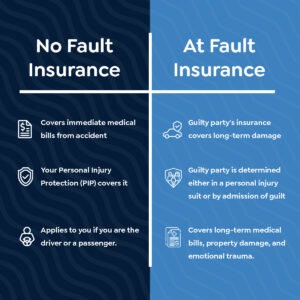Last updated on April 4th, 2024 at 12:41 am

At-fault and no-fault insurance policies in any country can play a crucial role in understanding the accident law of that country. These laws will affect how you handle insurance policies or claims and who will be responsible for your accident.
When we talk about California, it follows a fault-based system for car accidents.
This means that the driver who is found to be at fault for causing the accident is responsible for covering the damages. In California, you can file a claim based on the evidence presented, such as police reports, witness statements, and other documentation.

Difference between a no-fault and an at-fault state
These two differences can impact your insurance policies. If you’re living in a no-fault-based country, you will be considered directly to blame for the accident. Your insurance company (if you’ve got any) will not receive anything from someone else.
On the other hand, if you’re living in a fault-based system, your insurance company will be responsible for receiving the amount of the claim from the other person’s insurance company responsible for the accident.
People living in California must file car law suits with the at-fault insurance company if they face any accidents. The person who is not at fault and the person at fault can sue each other for their property damages or injuries in an auto accident. The person with no fault can file a case at the police station. The insurance company collects evidence while relying on the police report and determines the percentage of the claim.

How Faults Are Determined in California
Fault is typically determined based on the concept of negligence in California. In cases of comparative negligence, the insurance company determines the part of fault. Comparative negligence means that both parties have some fault during an accident.

The insurance company determines the percentage of each party’s claim and reduces the payout based on their determination. Factors such as speeding, running a red light, or driving under the influence are often considered evidence of negligence.

California Liability Insurance
In California, people usually purchase auto injury insurance policies to complete their requirements. A driver can purchase a higher amount of insurance; however, they must have a minimum amount of automobile insurance coverage, like:
The body injury or death of one person may have $15,000 in insurance liability. However, in cases of serious injury or death, more people may have $30,000 in liability insurance. For property damage coverage, they need $5000 in liability insurance. In addition, liability insurance coverage doesn’t cover medical expenses or minor injuries, but it can cover losses if you face a car accident.
Impact on Insurance Claims
When you are involved in an accident in a fault-based state like California, the insurance company of the at-fault person will be responsible for covering the damage. That means it covers the cost of damages and injuries that you may cause to others in a car accident where you are at fault.

On the other hand, when you’re involved in a car accident in California where the other driver is at fault, there are several important steps to take regarding your insurance claim:
- Safety First: If you’re first involved in a car accident, call emergency services and seek medical treatment. The presence of police will make it easy for you to gather all the evidence of an accident and help to strengthen the insurance claim.
- Exchange Information: Exchange all the necessary information regarding the driver and vehicle. It may include their name, address, phone number, driver’s license number, license plate number, and insurance policy number.
- Document the scene: Taking a photo of the scene will help you solve half of your case. Take photos of all the damages on the scene, like the vehicles involved, any visible damages, road conditions, traffic signs, and signals. This documentation can help support your insurance claim.
- Notify Your Insurance Company: This is a step that you must take as soon as possible. Provide them with the details of the accident and any documentation you have gathered.
- Seek medical attention: Don’t neglect any minor injuries; it may be possible that the injury you’re taking care of may become bigger in the future. To avoid such things, it’s important to seek medical attention after an accident.
- Keep Records: Medical records will help you to clear your claim. Keep all records related to the accident, including medical bills, repair estimates, rental car receipts, and any communication with insurance companies or other parties involved.
Consider Legal Assistance:
If you encounter difficulties with your claim or if you believe you are not receiving fair compensation, it is better to ask for professional help. A personal injury lawyer will guide you in the right direction, and you’ll be able to get the compensation you deserve. A professional car accident lawyer has the experience to deal with these hard circumstances.
They understand how fault is determined and the impact it has on insurance claims, which can help you navigate the aftermath of a car accident in California.





